Common AZ fungi in mixed conifer woods
In Arizona, mixed conifer forests occur at high elevation and recieve the greatest amount of precipitation. The dominant trees here are a mixture of Ponderosa Pine, Douglas Fir, and Quaking Aspens. Other Colorado Plateau pines and firs may also be found in these areas but at far lower occurances.
Mixed conifer forests are the ideal location for mushroom hunting. Rich, thick humus and heavy canopy cover combine with good host species and better climate to generate the most ideal conditions for fungal growth in the state. Here you will find the greatest abundance and widest variety of mushrooms.
All fungi listed in the Ponderosa Forest section also occur in the mixed conifer forest:
- Slippery Jacks
- Russula and Lactarius
- Earthstars
- Conks, shelves, brackets
- Gymnopilus
- Caesar's Amanita
- Morels
Agaricus spp.
Ahh, Agaricus. No mushroom is as widely known and as widely used as Agaricus. Your store bought white button, cremini, and portobello mushrooms belong to this genus. And, as any forager can tell you, the wild varieties of this mainstay mushroom are far superior to any supermarket source.
Agaricus is a detritus decomposer, and often incorporates dung in its lifecycle. The meadow varieties are often encountered in pastures. In fact, Agaricus ecology has been greatly influenced by the introduction of ranching. I am certain that prior to the settling of the west, that Bison were a major player in Agaricus ecology. There are also a good share of sylvan Agaricus. Because of the arid Arizona climate, you can expect to find Agaricus most often within, or in proximity to high elevation forests.
For help in identifying Agaricus, take a trip to your grocer and have a look at a Portobello. Most species of Agaricus have a lighter colored cap, but all the features are still there:
- Typically of large size
- A tightly domed cap when young but flattening out at maturity.
- Cap has flatened fiber tufts that radiate out from the center.
- Gills are pink when young, and turn dark chocolate brown in age
- Gills do not physically connect to the stem.
- Sporeprint is chocolate brown
- Has a ring, but no special stem base.
- Grows singly, but there can be several close together.
- Can also form fairy rings.
IMPORTANT:
- Can have an almond or asphalt odor when crushed / cut.
- Can stain yellow when rubbed, and/or when the base of the stem is cut
These two characters MUST BE NOTED and referenced with your ID guide.
Be sure to visit the "Know Your Enemy" section of the website, as there are some nasty sickening members of Agaricus.
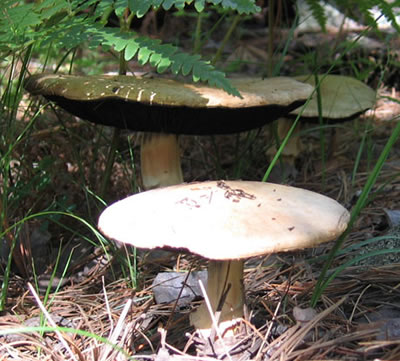
A trio of sylvan Agaricus
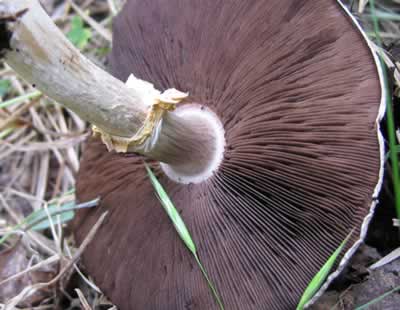
A view from underneath. How many key features can you see?
Amanitas
Amanita is a genus of both fame and infamy. It posesses species that are outright deadly, others that are highly prized as edibles, and one that has been used as a hallucinogen for centuries. All are mycorrhizal.
The key identifying features of Amanitas are:
- Long, straight stem
-
Cap margin often striated
- Specialized base: typically bulbous and possibly scaly
-- Additionally at base, a sac called a volva is typically present
- Skirt connected at the top of the stem, typically present
- White spores on free gills (some species have colored gills)
- Almost always in the presence of conifers.
- Typically medium to large in size.
Be sure to visit the "Know Your Enemy" section of the website. You are almost guaranteed to find Amanitas during the mushroom season, and the genus contains deadly species you should know.
Fly Agaric
- Amanita muscaria
The Fly Agaric is an unforgettable, unmistakable mushroom of art and lore. With its bright red color, white warts, and impressive stature, you will know instantly if you encounter one.
The Fly Agaric is mildly poisonous, and has been used historically to stupify flies when added to a bait such as milk. The European variety had hallucinogenic qualities, but the North American variety does not.
Caesar's Amanita (See description in Ponderosa section)
Grisettes
- Amanita vaginata and others
As a general rule, grisettes are Amanitas that lack a skirt. Grisettes are worth familiarizing yourself with because of how commonly they are found, and how they lack a feature characteristic of many Amanitas. I typically find members of the grisettes in forest / grove peripheries that mix with Aspens. This could be due to ecological relationships with Aspens, or that they favor the moist conditions where Aspens are found.
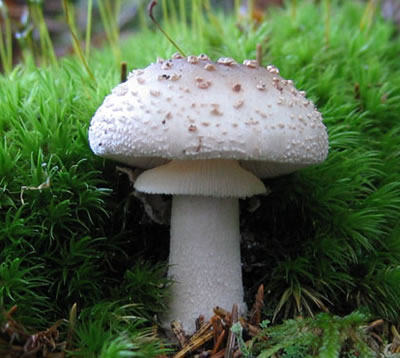
My favorite Amanita I've found so far...
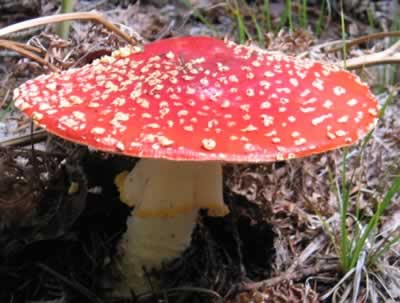
The most classic of all Amanitas: Amanita muscaria.
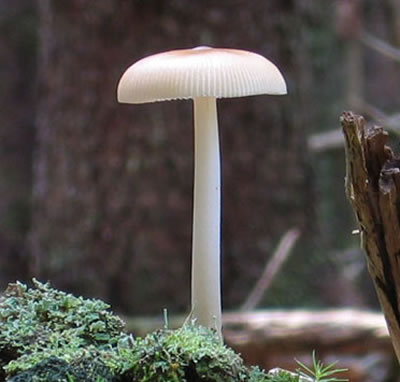
Grisettes: skirtless Amanitas.
Many Boletes
- (Slippery jacks, King bolete, Aspen bolete)
As has been mentioned in previous sections, boletes are classically-shaped mushrooms that are pored rather than gilled.
King bolete
- Boletus edulis
Cepe, Porchini, Steinpilz, Beli Gribe; the King Bolete is among the most highly prized of all culinary mushrooms. In Arizona, it occurs sparsely in the presence of Douglas Fir. A thorough day's foray should uncover at least one, but to find more than a few is a great victory for even a seasoned forager.
A sister species of the King Bolete, and in every way its equal on the table, is Barrow's Bolete (Boletus barrowsii). This bolete is found under Ponderosa Pine, and tends to be found less commonly than the King Bolete. However, it is certainly easier to spot as it is entirely white and usually quite large!
Aspen bolete
- Leccinum insigne
The Aspen Bolete is the bolete you should be looking for in Arizona. It can occur in abundance, and it has a specific host: the Quaking Aspen. Any Aspen grove is a valid target for this mushroom. As with many mycorrhizal mushroom producers, walking deep into the grove can be far less productive than inspecting its periphery.
The Aspen Bolete belongs to the genus Leccinum, a sister genus to Boletus. The characteristic feature of Leccinum is the presence of scabers on the stem. Look at the example photo to the right. Compare the photo of the King Bolete with that of the Aspen Bolete. No other bolete that occurs commonly in Arizona posesses this combination of characters.
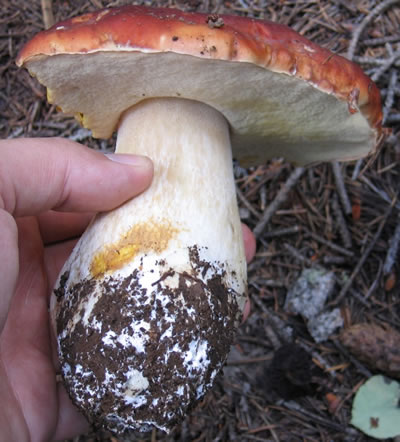
A king bolete. As of yet, none have survived discovery long enough to provide an in-situ photograph...
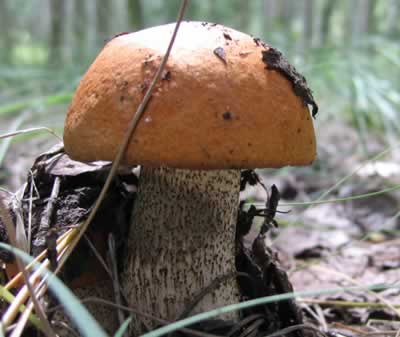
The aspen bolete. Note the scabrous stem.
Corals
- Ramaria spp. and others
Corals are a really fun group of macrofungi to find because they are so different and have such interesting appearances! Almost all coral fungi in Arizona are mycorrhizal with conifers. They can appear in great numbers, and can grow to very large size. A few coral fungi are edible, but they can be especially hard to identify to species (and even harder to clean their innumerable nooks and crannies!).
Often found alongside corals are finger-like projections called earth-tongues. These are not corals, and belong to the ascomycetes (all the corals are basidiomycetes).
As you can see in the photo, corals can be quite photogenic, and I highly recommend that you examine them closely for their fascinatingly exotic aesthetics.
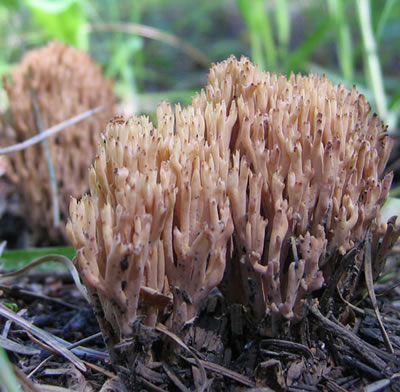
Cortinarius spp.
Cortinarius is a mycorrhizal genus with many, many members. They often produce large solitary mushrooms that look like excellent edibles, but almost all Cortinarius are inedible or sickening.
The genus Cortinarius have these key features:
- Rusty brown sporeprint
- Exclusively mycorrhizal
- In place of a ring, they have a cobwebby veil called a cortina.
-- Note that the cortina can disappear with age and/or rain.
You can expect to find Cortinarius on most any late summer-fall foray. They are common and often conspicuously large. Often they will have some useful distinguishing characteristic that makes identifying them fun. Keep your nose open for the anise cort, which I have found a few times over the last few years.
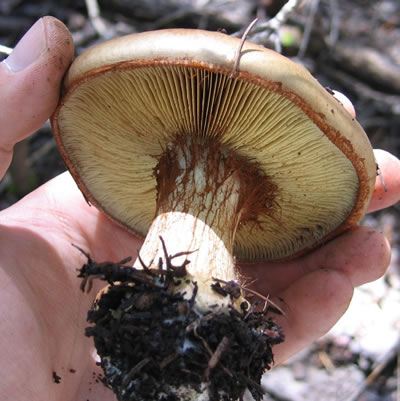
A classical Cortinarius with a conspicious cortina.
Honey mushrooms
- Armillaria spp.
Honey mushrooms are amazing fungi that can inhabit vast regions of the forest as a single organism. They produce specialized filaments called rhizomorphs that allow them to span great distances and transport nutrients between colonized locations. In certain parts of the country, especially the Pacific Northwest, honey mushrooms are pathogens of conifers and cause widespread tree death.
There are many different species in the honey mushroom group; the honey mushrooms in Arizona are not believed to be pathogenic. They will make their appearance most often at the base of dead trees and stumps. Less commonly you may find them emerging from the forest floor from buried wood or roots.
Honey mushrooms are a great mushroom to familiarize yourself with, as they are an excellent edible and can occur in large quantities. At issue is how closely they resemble many other wood rotting mushrooms that are not edible.
Properties:
- Occur always in clusters
- Thick, fibrous stem with visible linear fibers on surface
- Minor (not major!) scales on cap radiating outward from center
- Tan tissue and gills
- A ring is present on the stalk
- Occurs on wood, possibly buried wood
- White sporeprint. Check lower caps for a white imprint.
Become familiar with the honey mushroom lookalikes:
- Pholiota squarrosa
- Pholiota mutabilis
- Gymnopilus spectabilis
- Galerina spp. (Poisonous! Read this article!)
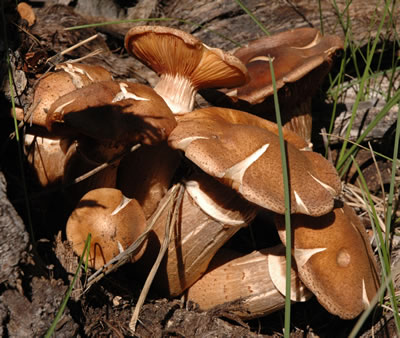
Fat-stemmed variety growing from the base of dead aspen.
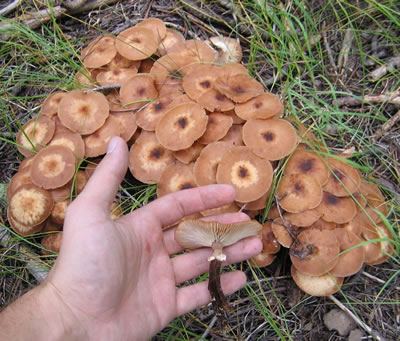
This cluster has many features of honey mushrooms... but if you took a sporeprint you would find they produce brown spores! Beware this lookalike: Pholiota mutabilis!
Jack O'Lantern
- Omphalotus olivascens
Jack O'Lanterns are great fun to find. Not only are they large, brightly colored and simply elegant in their oyster-mushroom appearance, they also have a unique chemical quality that you might guess from their common name... Yes, Omphalotus olivascens glows in the dark! This is not a "light your way home" kind of light; it is quite faint; but you certainly can see the glow close up on a moonless night. While I have found Jack O'Lanterns commonly in Arizona, I can not say that I have ever seen one glow. I have read many accounts of phosphorescence in these mushrooms, but all reports are from the east coast.
O. olivascens is a wood rotter that most commonly is found at the base of standing dead trees, stumps, or logs. It is often mistaken for oyster mushrooms due to its identical shape and size, in addition to it being one of the few oyster lookalikes with white spores. However, the orange color of the flesh should be a dead giveaway.
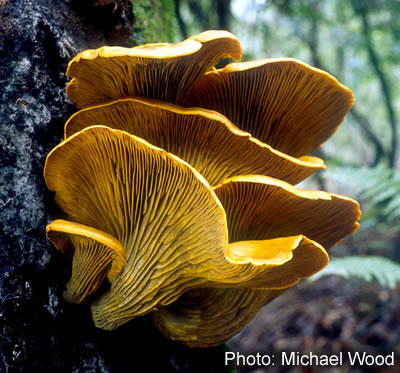
A fantastic photo of O. olivascens. Note the similarity to oyster mushrooms.
Photo: Michael Wood ; MykoWeb